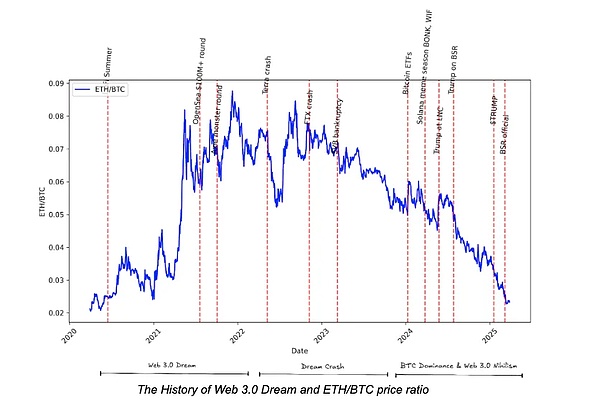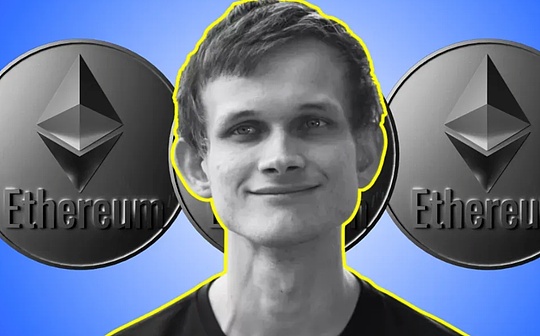
Author: Momir @IOSG
TL;DR
The craze of Web3 vision has faded in 2021, and Ethereum is facing severe challenges.Not only is the market’s cognitive shift in Web3.0, Ethereum is also facing fierce competition for the remaining market share by emerging platforms such as Solana.Key issues such as Layer 2 fragmentation, erosion of value attribution, dilution of ecological control rights, and insufficient leadership have further weakened Ethereum’s user experience and economic value, and with the increase in the voice of Layer 2 network, the influence of Ethereum has been shaken.These factors ultimately led to one of the most dramatic price pullbacks in history for ETH.
However, hope remains: Ethereum still has the opportunity to regain its glory by promoting L2 interoperability, prioritizing ETH-centric infrastructure, and adopting a decisive, performance-oriented leadership approach.Ethereum’s solid underlying architecture and vibrant developer ecosystem remain its lasting advantages, but to restore ETH’s excellence, strategic action must be taken quickly.
The cognitive shift from Web3.0 utopia to cruel reality forces the market to revisit Ethereum’s core value proposition.The ideal of “user-autonomous decentralized Internet” that was once highly anticipated has now been replaced by a more ironic narrative: the cryptocurrency field is either a Bitcoin stored value game or a digital casino.This emotional reversal has a particularly significant impact on Ethereum: it claims to be the cornerstone of the new Internet paradigm, but has to face growing doubts.
What’s even more serious is that Ethereum is no longer the only endorsement of the Web 3.0 vision.Whether it is optimistic or pessimistic about the future of the industry, it is not difficult to see that platforms such as Solana are becoming the new center of crypto consumption activities.Against this background, this article aims to dissect Ethereum’s most pressing strategic challenges and propose practical solutions to help it gain a new advantage in the ever-evolving landscape.


Core Challenge
Ethereum faces many challenges, but this analysis focuses on the four most pressing issues – L2 network fragmentation, declining value capture capabilities, dilution of ecological control and lack of strategic leadership.
L2 Network fragmentation and user experience separation
The most significant crisis is Layer2 network fragmentation.The introduction of multiple competing execution layers has separated user experience and on-chain liquidity and eroded the composability advantage that Ethereum mainnet once proud of, and this advantage is still clearly visible in monolithic blockchains such as Solana.
For users, they have to deal with inconsistencies in various protocols, standards and cross-chain bridges, making the seamless interaction that Ethereum originally promised is difficult to achieve.Developers have to bear the burden of maintaining multi-version protocols on multiple L2s, and entrepreneurial teams are also facing complex market entry strategies because they have to allocate limited resources in a scattered ecosystem.As a result, many consumer-facing applications choose to switch to Solana, where users and entrepreneurs can focus on entertainment and innovation without having to worry about fragmented infrastructure.
Ecological control dilution: an increasingly serious threat
What’s more serious is that Ethereum outsources its expansion roadmap to L2, and this decision is constantly weakening its control over its own ecosystem.The universal L2 Rollup will have a strong network effect when building its own ecology and gradually evolve into an insurmountable moat.As time goes by, these execution layers have increased their voices compared with the Ethereum settlement layer, and the community may gradually ignore the importance of the main network settlement layer.Once assets begin to exist natively at the execution layer, Ethereum’s potential in value capture and influence will be greatly weakened, and the settlement layer will eventually become a commoditized service.
Erosion of value attribution: Structural challenges
The rise of L2 has significantly affected the value capture of ETH, and these platforms increasingly occupy MEV and transaction fee revenue, significantly reducing the value of returning to the Ethereum main network.This shift to direct economic interests from ETH holders to L2 token holders weakens the inherent motivation for holding ETH as an investment asset.Although this trend is an inevitable challenge for any Layer 1 token: whether it is a modular Ethereum or a monolithic integrated chain, Ethereum has experienced this phenomenon earlier and more clearly because of its earliest practice of the L2 centralized route.
It can be foreseen that when the application layer leads MEV capture becomes the norm, not only monolithic blockchains will face similar dilemmas, but even L2 itself will encounter a value capture crisis.Although this is not a unique dilemma for Ethereum, how to formulate precision strategies to deal with this structural challenge is still a core proposition that needs to be solved urgently.
Leadership Crisis: Idealist Dilemma
Ethereum also exposed deep strategic leadership flaws when responding to the above challenges.The community has been trapped in the repeated trade-offs between efficiency goals and egalitarian values for a long time, delaying key progress.At the same time, the persistence of the “credible and neutral” governance commitment, although its original intention is to reduce the risks of supervision and national crackdowns, is often a shackle of strategic decision-making.In addition, ETH holders lack mechanisms that directly affect major strategic choices, and their only way to express dissatisfaction is often to sell tokens.
In hindsight, these issues, while easily defined, may have been attributed to considerations of regulatory pressures and national risks rather than lack of insight into governance and leadership.

Strategic response: Challenges and solutions
L2 Network fragmentation: Self-correction mechanism
Two ways to resolve the L2 fragmentation crisis:
First, rely on market mechanisms (natural selection) to achieve organic integration of the ecosystem, and ultimately form 2-3 general-purpose L2-dominated markets with absolute activity.The remaining projects either exit competition or transform into Rollup service providers for vertical scenarios;
Second, by establishing strong binding interoperability standards, we can eliminate internal friction in the Rollup ecosystem and prevent a single execution layer from building a monopoly moat.
Ethereum should seize the current window period where it still has influence on L2 and promote the implementation of the second solution.We need to be clear that this dominance is continuing to be lost on a daily basis, and the slower the action, the weaker the strategic effectiveness.By building a unified L2 ecosystem, Ethereum is expected to regain the composability advantages of the main network era and compete with single-unit chains such as Solana at the user experience level.
However, relying solely on market-driven integration will blew the future prospects of ETH.Once a power law distribution around 2–3 dominant execution layers appears, Ethereum’s influence on these execution layers may be significantly weakened; in this case, each execution layer will often prioritize the value attribution of its own tokens, thereby marginalizing ETH and weakening Ethereum’s economic model.To avoid this situation, Ethereum must act decisively to shape its own L2 ecosystem and ensure that value and control are always bound to the mainnet and ETH.
Value recapture mechanism
Relying solely on the “productive assets” narrative is not a sustainable long-term strategy for ETH (and even all Layer1 tokens).The time window for Layer1 to dominate MEV capture has been maintained for up to five years, and it has become an established trend as the value capture hierarchy continues to migrate to the upstream of the application stack.at the same time,Bitcoin has firmly occupied the “store of value” narrative, if ETH tries to compete with BTC in this field, it may be regarded as “the poor Bitcoin” by the market, just like the positioning of silver relative to gold in history.Even if ETH can show obvious advantages in store of value in the future, this change may take at least a decade, and Ethereum is unable to wait for such a long cycle.Therefore, during this period, Ethereum must open up a unique narrative path to maintain its market relevance.
Positioning ETH as an “Internet native currency” and the best on-chain collateral is the most promising direction in the next decade.Although stablecoins dominate on-chain finance as payment mediums, they still rely on off-chain ledgers; the real Internet-native and unstoppable currency role has not been substantially occupied, and ETH has this first-mover advantage.However, to achieve this goal,Ethereum must regain control of the common execution layer in the ecosystem and will promote ETH adoption first rather than letting the proliferation of Wrapped ETH standards.

Reinforce the dominance of the ecosystem
Reestablishing ecological ownership can be achieved through two key ways:First, by improving the performance of Ethereum L1, it reaches a level comparable to the centralized chain, ensuring that consumer applications and decentralized financial experiences are free of delays; second, launching Ethereum-native Rollup to focus all business development and adoption efforts here.By focusing ecological activities on infrastructure controlled by ETH, Ethereum can strengthen ETH’s core position in the ecosystem.This requires Ethereum to shift from the outdated “ETH compatibility” paradigm to the “ETH-led” ecological model, prioritizing direct control of core resources and maximizing ETH value capture.
However, whether regaining ecological control or strengthening ETH adoption is a tricky decision that may alienate key contributors such as Rollup and liquid staking providers.Ethereum needs to weigh carefully, seeking a balance between strengthening control demand and community division risks to ensure ETH successfully establishes its new narrative as the cornerstone of the ecosystem.
Leadership innovation
Ultimately, Ethereum leadership must innovate to meet governance and strategic challenges.Ethereum leaders need a performance-oriented thinking model, a stronger sense of urgency, and a pragmatic attitude to promote ecological development.This shift requires abandoning previous overly persistent in “trustworthy neutrality”, especially when deciding on product roadmap and ETH asset positioning, which requires more decisive decisions.
Meanwhile, the market has expressed dissatisfaction with Ethereum’s practice of outsourcing critical infrastructure — from Rollup to staking — to decentralized entities.To reverse this situation, Ethereum must bid farewell to the old model of “aligning with ETH” and turn to the new model of “dominantly led by ETH”.Ensure that core infrastructure is unified under a single token system ($ETH).This move will further consolidate ETH’s core position and restore market confidence in the strategic direction of Ethereum.

Marketing Challenges and Narrative Potential
Despite many challenges, Ethereum has a deep advantage in supporting its crypto space—which are often downplayed by its leadership, causing negative criticism to obscure its core narrative.Systematically sorting out these advantages will help establish an objective cognitive framework for Ethereum’s potential.
Proven infrastructure
Ethereum is tied with Bitcoin to provide unparalleled decentralized security and meets the strict requirements of sovereign institutions and large financial institutions.The security guarantee provided by the consensus mechanism far exceeds other smart contract platforms, ensuring true censorship resistance – this is indispensable for infrastructure that carries a value of hundreds of billions of dollars.Ethereum DeFi ecosystemA total of approximately US$76.32 trillion in value (TVL× days) has been guaranteed, and there are very few major security incidents, and the time-verified security moat continues to deepen.
Currently, the scale of stablecoins custodial on Ethereum has exceeded US$120 billion, and these funds have been accumulated mainly in an era when the regulatory framework is not yet clear and the widespread adoption of institutions has not yet been formed.As the regulatory environment gradually becomes clear and institutional demand drives further growth in stablecoins,It is expected that the size of stablecoins custodialized by Ethereum will exceed US$1 trillion in the next decade.This growth comes from the demand for new issuances, but also from the market’s trust in its security and composability, and may consolidate its platform as the cornerstone of global finance.
Foresight design
Ethereum’s architecture is significantly forward-looking.Compared to Bitcoin, it providesMore complete transitional solution for quantum attack resistance, its continuous evolutionary technology culture drives innovation.Unlike the security budget constraints that $BTC may face in the future, Ethereum’s flexible monetary policy allows it to maintain strong security incentives while adapting to the market environment, ensuring long-term resilience.
An unparalleled developer ecosystem
Ethereum has the largest and most diversified developer community in the blockchain field, and has accumulated knowledge systems and best practices in the past decade.This intellectual capital and social capitalBuild another moat for the EVM ecology, making it continue to lead in innovation speed and application scale.
Modular Path: The Only Solution to Scalable Decentralized Systems
Ethereum’s modular design has made important progress in balancing decentralization, scalability and security.As time goes by, it is becoming increasingly obvious that if a single chain wants to achieve a global financial scale, it must be at the expense of decentralization;Ethereum’s modular strategy is the only feasible solution to achieve sustainable scaling while maintaining trust minimization and decentralization., the correctness of this strategic choice will become more and more prominent over time.
The most customizable technology stack
Ethereum’s L2 ecosystem provides unparalleled customizability, making it the preferred platform for vertical scenario applications and institutions.Institutions can build exclusive L2 based on Ethereum L1 and use technologies such as fully homomorphic encryption (FHE) to achieve privacy protection; companies such as Robinhood can replicate the traditional financial order flow payment mechanism on their own L2 through the “sort right payment” model.These L2s are anchored to Ethereum L1 – the world’s most secure public ledger – to form a unique security redundancy: Even if a certain L2 fails, users can still return L1 for trustless settlement. This “ultimate security network” is the unique value proposition of the Ethereum ecosystem.

Market Signal: ETH enters historic oversold range
ETH’s recent price trends have made it an unpopular target in the eyes of investors, and ETH holders have expressed a lack of confidence in recent developments through their selling behavior.This sharp decline has only happened six times in the decade of ETH, five of which occurred in the early stages.For Ethereum, which has entered its tenth year of development, encountering such a scale of value revaluation in its maturity stage is undoubtedly a warning signal to the entire ecosystem that cannot be ignored.Historical data shows that there have been strong rebounds within six months after the first five similar callbacks, which injects a glimmer of hope into the current dilemma.However,Whether ETH can reproduce historical laws or continue the current steep downward trajectory will directly depend on the strategic signals released by Ethereum leadership in the short term and the strategic implementation in the next twelve months.Despite the challenges, the current situation is not irreversible, and a strong recovery is expected if practical strategies can be formulated and implemented.
To reshape industry leadership and restore market confidence in ETH, Ethereum must immediately start to meet the following core challenges: First, a sound L2 interoperability standard needs to be enforced to alleviate fragmentation and retain the seamless composability that the mainnet once defined; second, it must shift from the old model of “aligned with ETH” to an ecological model of “ETH-led”, prioritizing L1 expansion and Ethereum native Rollup to re-establish control and maximize ETH value capture; finally, leadership must evolve towards a performance-driven decision-making method, abandoning “trustworthy neutrality” and unifying critical infrastructure under the $ETH token system.If we cannot act decisively, Ethereum will face the risk of being eroded by competitors such as Solana and becoming a commercial settlement layer.








